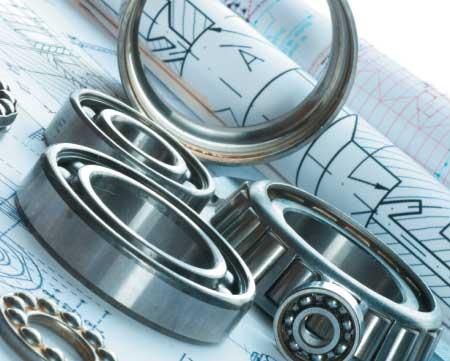|
How you mount your bearings will determine the life and performance of the bearings in the long term. Proper bearing handling and mounting methods will prevent you from unplanned shutdowns and bearing failure that would cost you thousands
of dollars.
Cleanliness: The first rule
Cleanliness is the first rule of proper bearing handling. Whenever possible, keep the working environment clear of sand, sawdust, cement, corrosive substances, and high humidity. Prior to bearing installation, thoroughly clean and dry the shaft and housing. Cover exposed areas with plastic sheeting or lint-free cloth when you are not working with the bearing.
New bearings should be kept in their packaging until mounting. Do not wash new bearings or remove the rust-inhibiting compound (except from the bore and the outer ring’s surface). Thoroughly inspect and clean used bearings prior to installation. Lubricants should be clean and fresh. Keep lubricant containers closed until the lubricant is needed. Use the right type and quantity of lubricants, as contaminated lubricants, or incorrect lubricant amounts, can cause early bearing failure.
Check shaft preparation
Ensure the shaft size is within its specified tolerances before you mount a bearing. The bearing seat should be perfectly round, and the shaft should be clean and free from nicks and burrs. Inspect the shaft for damage that may have occurred when the previous bearing was dismounted.
There are four basic methods for mounting bearings: mechanical, heating, hydraulic and oil injection. The correct method depends on bearing type and size.
Mechanical mounting
Mechanical mounting is generally suitable for small (4” or less O.D.) bearings. Place a fitting tool sleeve against the inner ring and use a press or hammer to advance the bearing to its proper location. Do not apply a sleeve to the outer raceway when mounting on a shaft, or to the inner raceway when mounting in a housing. Never mount a bearing by striking the bearing directly with a hammer. A spanner wrench, or impact spanner and lock nut, can be used to cold-mount small and medium-size bearings with tapered seats.
Heat mounting
Heat mounting is suitable for medium and large bearings, and for small bearings with cylindrical seating arrangements. A bearing temperature of 65.6 degrees C (150 degrees F) above shaft temperature (not to exceed 121.1 degrees C or 250 degrees F) should provide sufficient expansion for mounting. As the bearing cools, it contracts and tightly grips the shaft. It is important to regulate heat accurately, as excess heat destroys a bearing’s metallurgical properties. Heat mounting tools include induction heaters, ovens, heating rings and electric plates. Never use an open flame to heat a bearing.
Hydraulic mounting
Hydraulic mounting uses hydraulic pressure rather than mechanical force to mount bearings. A hydraulic ram mounts small bearings with straight and tapered bores. A hydraulic nut is recommended for bearings with bore diameters over 50 mm
(1.97 in.).
|
Oil injection
The oil injection method (which is sometimes used in conjunction with hydraulic bearing mounting tools) is suitable for all bearings with tapered seating arrangements and for large bearings with withdrawal or adapter sleeves. Oil injection forces high pressure oil through a passage between the shaft and the bearing’s inner ring. This minimises friction between the two parts.
SKF training
The SKF Bearing Technology and Maintenance course showcases the worlds best practice in bearings, principles of mounting and dismounting from engineers, using the correct fitting and removal tools and techniques. This course is directly aligned with the NZQA Unit Standard 19873, Demonstrate knowledge of bearings used in machines and equipment and Unit Standard 19874, Service and replace bearings in machines and equipment. SKF delivers the course under the auspice of Manukau Institute of Technology.
Article by Rob Bertz, SKF @ptitude Exchange.
Email: jim.evans@skf.com
|






